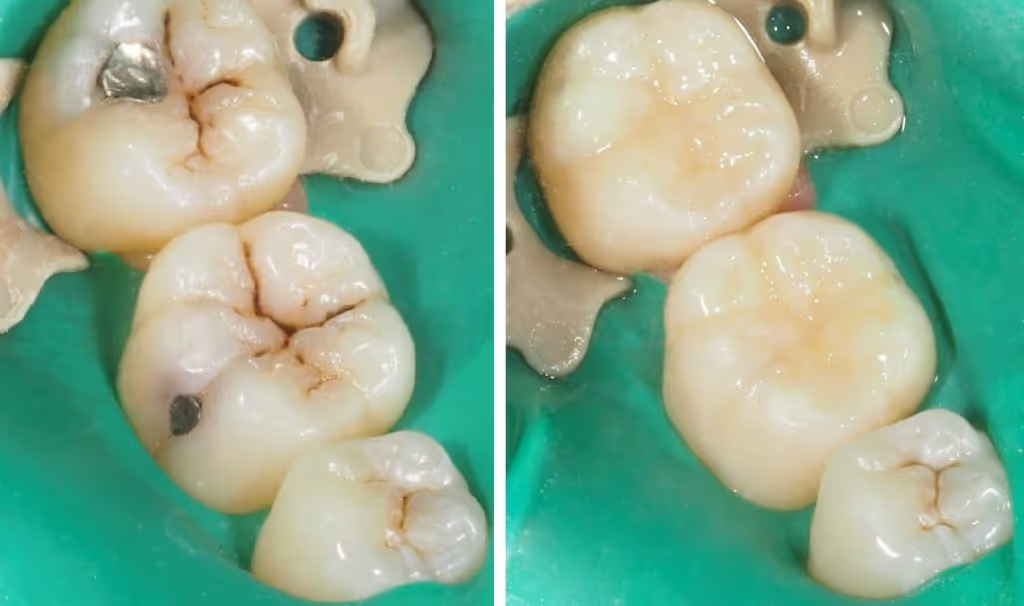Amalgam Removal
Whether you’re concerned about aesthetics, cracking or leaking fillings, or mercury content, we offer safe, thorough amalgam removal with modern, tooth-coloured alternatives. At Riseley Street Dental, we take pride in doing this work to a high standard—carefully removing old silver fillings using isolation and modern techniques to protect your teeth and overall health.

Safe, Clean Replacement of Old Silver Fillings
Whether you’re concerned about aesthetics, cracking or leaking fillings, or mercury content, we offer safe, thorough amalgam removal with modern, tooth-coloured alternatives. At Riseley Street Dental, we take pride in doing this work to a high standard—carefully removing old silver fillings using isolation and modern techniques to protect your teeth and overall health.
Why Patients Choose to Replace Amalgam Fillings
- Cracks or fractures in the tooth from expansion of the metal
- Dark staining or shadowing of enamel around the filling
- Leaking margins, recurrent decay, or failing bond
- Desire for a natural-looking, tooth-coloured restoration
- Concerns about mercury exposure or long-term health impacts
Not every amalgam filling needs to be replaced—but if it’s failing, visible, or you’re ready for a cleaner, more modern solution, we’ll walk you through the safest and most effective way forward.
Our Approach to Safe Amalgam Removal
We use a clean, controlled approach tailored to the situation and the tooth. While rubber dam isolation can be beneficial and is generally recommended—especially to prevent debris from being swallowed or inhaled—it’s not always necessary for safe removal. In many cases, we use high-volume suction, water spray, and careful segmental removal techniques to minimise dust, exposure, and unnecessary trauma to the tooth.
Tooth-Coloured Alternatives
Once the amalgam is removed, we restore your tooth using high-quality, durable materials suited to its condition and location:
- Composite resin – Tooth-coloured and bonded, ideal for smaller restorations
- Ceramic inlays, onlays, or crowns – Digitally designed for strength, aesthetics, and longevity
- Gold – The longest-lasting material available, still preferred in some cases for durability and biocompatibility
We don’t just replace the filling—we rebuild the tooth with the same attention to detail we bring to all restorative work.

Amalgam Replacement in Booragoon, Ardross, Applecross & Surrounds
We’ve helped many patients safely and confidently replace their silver fillings with stronger, more modern restorations. Whether you’re motivated by health concerns, aesthetics, or damage to the tooth, we’ll take the time to do it properly—with no shortcuts and no pressure.
FAQs: Amalgam Filling Removal
Is amalgam removal safe?
Yes. With modern suction, cooling, and controlled removal, amalgam can be safely removed without health risk. We offer rubber dam isolation where appropriate, but it’s not essential in every case.
Will my new filling match my natural teeth?
Absolutely. We use tooth-coloured materials that are carefully matched to your existing teeth for a seamless, natural result.
How long does the procedure take?
Most amalgam replacements take 30–90 minutes, depending on the size and complexity of the filling and the type of restoration being placed.
Are all amalgam fillings bad?
Not at all. Well-placed amalgam can last for many years. We only recommend replacement if the filling is failing, the tooth is compromised, or you have a specific reason to want it removed.
Let's take care of your smile, the right way.
Experience personalised care, a calming atmosphere, and a genuine commitment to doing good dentistry. Start your journey with a team that focuses on the details that truly matter.
Commonly asked questions about our practice
Here are some common questions we get asked, along with clear, straightforward answers
Yes, we can organise payment plans through trusted third-party providers. Let us know if you'd like to spread out your treatment costs—we’ll talk you through what’s possible without any pressure.
Yes! We take a thoughtful and calm approach to care and will always go at your pace. We also offer sedation options for more complex or lengthy procedures. If you’re nervous, feel free to let us know ahead of time so we can help make the visit more comfortable.
We focus on detail-oriented, high-quality care designed with longevity in mind. Each treatment is approached with careful planning and clinical consideration, with the aim of achieving results that are both functional and long-lasting. We take the time to listen, collaborate, and tailor care to each person’s needs—so patients feel informed, confident, and well-supported at every step.
Yes, you’re welcome to request a specific clinician when booking.
Yes, we have parking available on-site. We’re also accessible by public transport.
Let's take care of your smile, the right way.
Experience personalised care, a calming atmosphere, and a genuine passion for detail. Start your journey with a team that focuses on what truly matters.